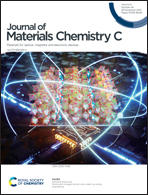Enhancing the brightness of CsPbBr3 quantum dot electroluminescence light-emitting diodes by manipulation of PEDOT:PSS films†
Abstract
With solution-processability, low-temperature proper energy level and superior stability, poly(3,4-ethylenedioxythiophene):poly(styrene sulfonate) (PEDOT:PSS) is one common hole-transport material for the quantum dot light-emitting diode (QLED) application. However, the conductivity of the traditional PEDOT:PSS is very low, which has an adverse effect on QLED devices. Herein, one surface-annealing method for the PEDOT:PSS film to exchange their original composition and surface morphology is proposed. The advantage of this approach lies in the fact that the conductivity of the PEDOT:PSS film annealed with toluene (1.25 S cm−1) and ethylene glycol (EG, 10.52 S cm−1) are obviously improved compared with the air-annealing method (0.13 S cm−1). The difference is that the EG-washed PEDOT:PSS film shows a relatively rough surface with more PEDOT domains, whereas the toluene treated PEDOT:PSS film can promote the formation of a smooth, PSS-dominated surface and change the PEDOT chain structure from coiled to linear, thus, the conductivity of the PEDOT:PSS film is enhanced. As a result, the QLED device achieves a maximum luminance of 31 140 cd m−2 and power efficiency of 13.4 lm W−1, showing 48% and 25% enhancements, respectively, compared to the control device. This work provides an efficient approach for improving of perovskite QLED performance.



 Please wait while we load your content...
Please wait while we load your content...